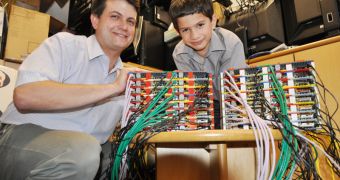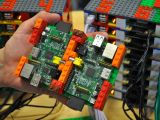While we did see the Raspberry Pi in a variety of situations, none of them actually foreshadowed the creation of a supercomputer based on the small ARM-based Linux computer.
Nevertheless, a team of scientists from the University of Southampton accomplished this very feat, under the supervision of Professor Simon Cox.
Called Iridis-Pi, it doesn't actually fall in the same category as the mega systems that populate the Top500 list, but follows the same underlying principle.
64 Raspberry Pi boards have been combined, through use of Lego blocks, into a parallel computer with 1 TB of storage space, 16 GB of RAM (random access memory) and a single 13 Amp mains socket.
The total cost of construction was of $4,000 / 3,099 Euro, and that sum doesn't factor in the cost of the Ethernet switches used to link the boards together.
The storage capacity was achieved by outfitting each of the 64 Raspberry Pi PCs with a 16 GB SD memory card.
“As soon as we were able to source sufficient Raspberry Pi computers we wanted to see if it was possible to link them together into a supercomputer,” said professor Cox.
“We installed and built all of the necessary software on the Pi starting from a standard Debian Wheezy system image and we have published a guide so you can build your own supercomputer.”
The team is sharing the step-by-step instructions of building a Raspberry Pi supercomputer, so one can go here to read them if they are interested.
Hopefuls should keep one thing in mind though: this first version needed special software to run, one that Cox and his team designed over the summer, starting from the Debian Wheezy system image.
After using a free version of the Message Passing Interface, they used code written in Python (with Microsoft Visual Studio) to perform the parallel computing tasks.

 14 DAY TRIAL //
14 DAY TRIAL // 
